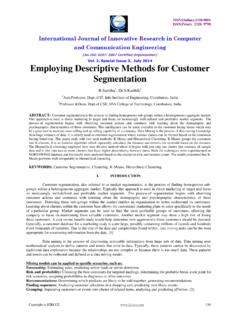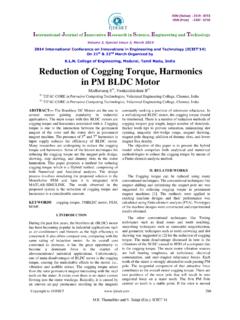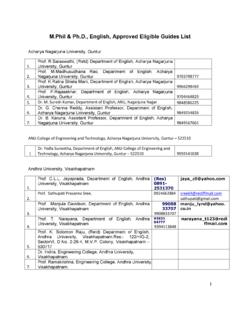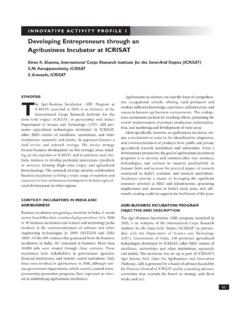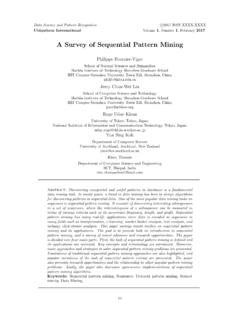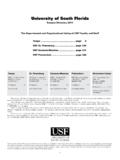Transcription of Load Frequency Control for A Multi Area Power …
1 ISSN (Online) : 2319 8753 ISSN (Print) : 2347 - 6710 International Journal of Innovative Research in Science, Engineering and technology An ISO 3297: 2007 Certified Organization, Volume 3, Special Issue 1, February 2014 International Conference on Engineering technology and Science-(ICETS 14) On 10th & 11th February Organized by Department of CIVIL, CSE, ECE, EEE, MECHNICAL Engg. and S&H of Muthayammal College of Engineering, Rasipuram, Tamilnadu, India Copyright to IJIRSET 1008 Load Frequency Control for A Multi Area Power System Involving Wind, Hydro and Thermal Plants N. Kiran Kumar1, Naidu1 Department Electrical & Electronics Engineering, GITAM University, Visakhapatnam, India1, 2 Abstract- In an interconnected Power system, as a Power load demand varies randomly both area Frequency and tie-line Power interchange also vary.
2 The objectives of load Frequency Control (LFC) are to minimize the deviations in these variables (area Frequency and tie-line Power interchange) and to ensure their steady state errors to be zero. In this area of energy crisis, renewable energy is the most promising solution to man s ever increasing energy needs. But the Power production by these resources cannot be controlled unlike in thermal plants. As a result, standalone operation of renewable energy is not reliable. Hence grid-connection of these along with conventional plants is preferred due to the improved performance in response to dynamic load. It is observed that fluctuations in Frequency caused due to load variations are low with increase in penetration of renewable resources.
3 Load Frequency Control (LFC) including PID controller is proposed in order to suppress Frequency deviations for a Power system involving wind, hydro and thermal plants owing to load and generating Power fluctuations caused by penetration of renewable resources. A system involving two thermal plants, a wind farm and a hydro plant will be modelled using MATLAB. Index Terms--Distributed Power generation, load Frequency , Control (LFC), wind Power , hydro Power , and thermal Power plants. I. NOMENCLATURE PC Command signal F Change in Frequency YE Changes in steam valve opening R Speed regulation of the governor Ksg Gain of speed governor Tsg Time constant of speed governor Rp Permanent droop Rt Temporary droop Tg Main servo time constant D Change in load with respect to Frequency Tw Water starting time Tr Reset time II.
4 INTRODUCTION The high Indian population coupled with increase in industrial growth has resulted in an urgent need to increase the installed Power capacity. In India, majority of Power production, around 65 per cent is from thermal Power stations. Due to problems related to uncertainty in pricing and supply of fossil fuels, renewable resources have been identified as a suitable alternative like solar, wind, and biogas plants are using in recent days. However, standalone operation of renewable resources is not reliable as they are intermittent in nature. The intermittent nature of resource increases the Frequency deviations which further add to the deviation caused by load variation. This necessitates the grid connection of renewable resources wind and solar.
5 Frequency deviation is undesirable because most of the AC motors run at speeds that are directly related to Frequency . Also the generator turbines are designed to operate at a very precise speed. Microcontrollers are dependent on Frequency for their timely operation. Thus it is imperative to maintain system Frequency constant. This is done by implementing Load Frequency Control (LFC). There are many LFC methods developed for controlling Frequency . They include flat Frequency Control (FFC), tie-line bias Control (TBC) and flat tie-line Control (FTC). In FFC, Some areas act as load change absorbers and others as base load. The advantage is the higher operating efficiencies of the base load as they run at their maximum rated value at all times.
6 But the drawback here is the reduced number of areas absorbing load changes which makes the system more transient prone. In FTC load changes in each area are controlled within the area, thereby maintaining tie line Frequency constant. The most commonly used method is ISSN (Online) : 2319 8753 ISSN (Print) : 2347 - 6710 International Journal of Innovative Research in Science, Engineering and technology An ISO 3297: 2007 Certified Organization, Volume 3, Special Issue 1, February 2014 International Conference on Engineering technology and Science-(ICETS 14) On 10th & 11th February Organized by Department of CIVIL, CSE, ECE, EEE, MECHNICAL Engg. and S&H of Muthayammal College of Engineering, Rasipuram, Tamilnadu, India Copyright to IJIRSET 1009 the tie-line load bias Control in which all Power systems in the interconnection aid in regulating Frequency regardless of where the Frequency change originates.
7 In this project, the Power system considered has a Thermal system with four thermal areas, a Hydro plant and a wind farm. III. MODELING OF THERMAL AREAS The thermal areas have been modelled using transfer function. Speed governor, turbine and generator constitute the various parts namely the speed governing system, turbine model, generator load model [7]. A. Speed Governing System The command signal PC initiates a sequence of events-the pilot valve moves upwards, high pressure oil flows on to the top of the main piston moving it downwards; the steam valve opening consequently increases, the turbine generator speed increases, the Frequency goes up which is modelled mathematically. YE(S) = [ PC(S) F(S)] ( ) (1) B.
8 Turbine model The dynamic response of steam turbine is related to changes in steam valve opening YE in terms of changes in Power output. Typically the time constant Tt lies in the range to sec. C. Generator Load Model The increment in Power input to the generator-load system is related to Frequency change as F(S) = [ PG(S) - PD(S)] ( ) (2) D. Entire thermal area Typical values of time constants of load Frequency Control system are related a Tsg<Tt <<Tps shows in the required block diagram below. Block Diagram of Thermal A complete block diagram of an isolated Power system comprising turbine, generator, governor and load is easily obtained by combining the blocks. Table Parameters of Thermal Areas Area Rated Power D(puMW/HZ) Per unit inertia constant H(s) Kps Tps Tp1 2000.
9 01 6 100 24 TP2 1000 .02 5 50 24 Tp3 600 .033 4 30 Tp4 2500 .008 6 125 30 IV. MODELING OF HYDRO AND WIND AREA The representation of the hydraulic turbine and water column in stability studies is usually based on certain Assumptions. The hydraulic resistance is considered negligible. The penstock pipe is assumed inelastic and water incompressible. Also the velocity of the water is considered to vary directly with the gate opening and with the square root of the net head and the turbine output Power is nearly proportional to the product of head and volume flow. [3] block diagram for hydro system Hydro plants are modelled the same way as thermal plants. The input to the hydro turbine is water instead of steam.
10 Initial droop characteristics owing to reduced pressure on turbine on opening the gate valve has to be compensated. Hydro turbines have peculiar response due to water inertia; a change in gate position produces an initial turbine Power change which is opposite to that sought. For stable Control performance, a large transient (temporary) droop with a long resettling time is therefore required in the forms of transient droop compensation as shown in The compensation limits gate movement until water flow Power output has time to catch up. The result is governor exhibits a high droop for fast speed deviations and low droop in steady state. ISSN (Online) : 2319 8753 ISSN (Print) : 2347 - 6710 International Journal of Innovative Research in Science, Engineering and technology An ISO 3297: 2007 Certified Organization, Volume 3, Special Issue 1, February 2014 International Conference on Engineering technology and Science-(ICETS 14) On 10th & 11th February Organized by Department of CIVIL, CSE, ECE, EEE, MECHNICAL Engg.






